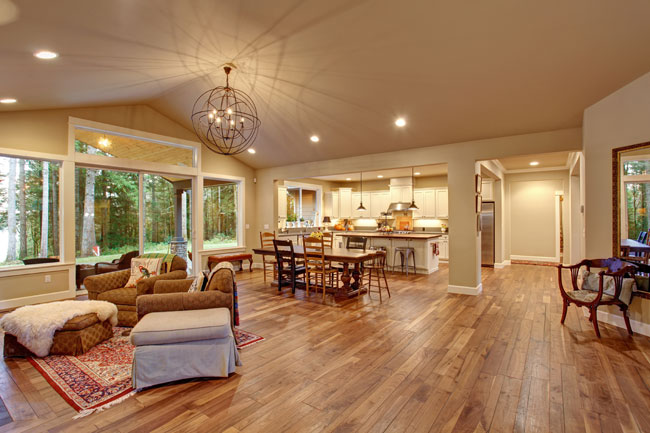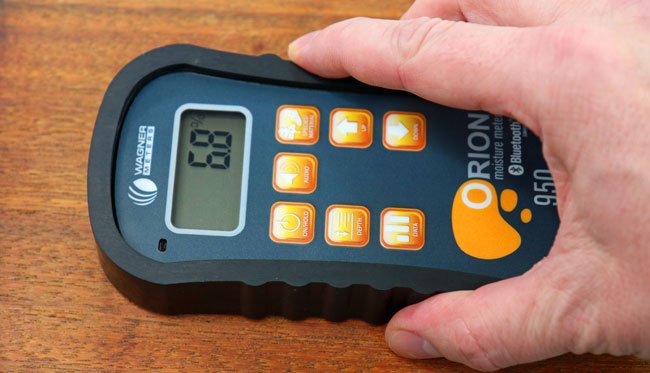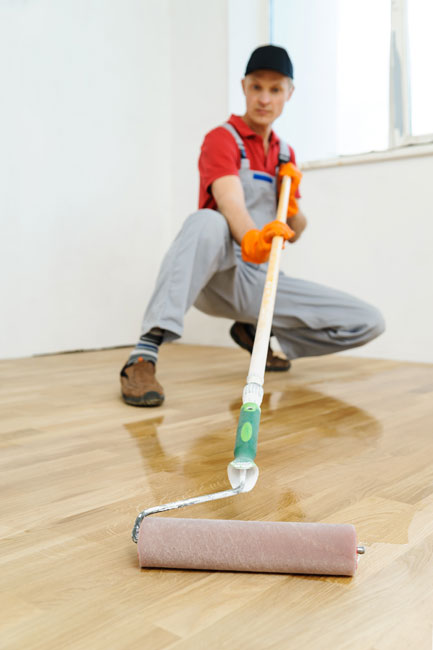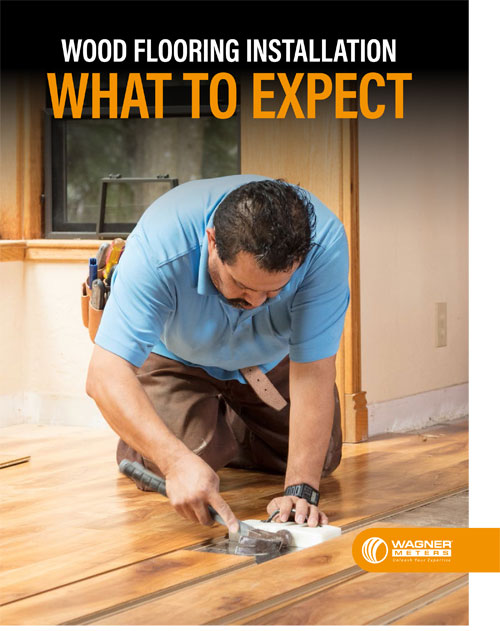Applying a Water-Based Finish to Your Wood Floor for a More Natural Look
Originally Published by Floor Covering Installer
Water-based urethane finishes are becoming more popular for hardwood floors. If you’ve never used one before, you’re sure to appreciate the eco-friendly low volatile organic compounds (VOCs), and your clients will love the more natural look that water-based urethane gives their hardwood floors.
 There are other advantages to “going natural.” During application, you can expect water-based urethanes to dry faster, level better and foam less – and they clean up with water instead of solvents. The low VOCs means there’s no need to use a respirator, and the job site is safer for you and your clients.
There are other advantages to “going natural.” During application, you can expect water-based urethanes to dry faster, level better and foam less – and they clean up with water instead of solvents. The low VOCs means there’s no need to use a respirator, and the job site is safer for you and your clients.
Since water-based finishes dry in approximately 2-4 hours, you can apply two coats of water-based urethane per day without intercoat abrasion. Oil-based urethanes must dry at least overnight and require intercoat abrasion between all coats.
Water-based finishes are fully cured between 4-7 days typically whereas oil-based urethanes take between 14-30 days to become fully cured.
Faster drying does mean you need to work quickly with water-based finishes, especially in warm, dry weather, so you need some experience with finishing floors before you attempt to use them. But the speed of installation, low odor, safety, and beautiful results are well worth it.
Get Tooled Up
First, you’ll need a sander or rotary buffer for sanding and screening – preferably one with an integral vacuum. You’ll also need a good shop vac for keeping the place clean.
It is important to use an applicator recommended by the manufacturer to ensure the right coverage rate. There are multiple options that are typically recommended, including roller application. Roller application finishes are becoming increasingly popular, especially European finishes. Be aware, however, that there are still some products that do not respond well to rolling application. Indirect air exchange with a fan is important for waterborne finishes but be careful to minimize drafts or breezes going directly across your wet finish. Too much airflow can cause the finish to dry too quickly and not allow it to lay out evenly, increasing your risk of application marks. Higher humidity will be your friend in this case since it sets up conditions which are generally more forgiving for application of water-based finishes.
Testing for Dryness
 The most important tool for ensuring a successful finish is a wood moisture meter. All wood flooring contains moisture, and if the wood isn’t dry enough, the moisture can prevent urethanes from properly bonding. Some moisture meters allow you to measure the equilibrium moisture content (EMC) of the wood. With consistent environmental conditions, this is the state that the wood will “live” in.
The most important tool for ensuring a successful finish is a wood moisture meter. All wood flooring contains moisture, and if the wood isn’t dry enough, the moisture can prevent urethanes from properly bonding. Some moisture meters allow you to measure the equilibrium moisture content (EMC) of the wood. With consistent environmental conditions, this is the state that the wood will “live” in.
The same holds true for each coat of sealer or finish. Each coat must be sufficiently dry before you apply the next coat. If it isn’t, the same bonding problems can occur.
Wood flooring comes in a range of thicknesses, so for hardwood floors, a moisture meter with a variable depth setting is best.
To avoid damaging the floor, make sure to use a pinless moisture meter.
The Wagner Orion® 930, 940, and 950 dual-depth, pinless moisture meters are among the most accurate in the industry and feature on-site calibration – an industry first. This makes them an excellent choice for finishing floors.
Application
 Once you have all your tools lined up, and your floor is properly cleaned and prepared you can proceed with the application of your water-based finish. Follow each finish manufacturers recommendations for application and never hesitate to reach out to their technical representative or department for any insights on their product.
Once you have all your tools lined up, and your floor is properly cleaned and prepared you can proceed with the application of your water-based finish. Follow each finish manufacturers recommendations for application and never hesitate to reach out to their technical representative or department for any insights on their product.
Try to ensure that the temperature in the room remains above 65 degrees Fahrenheit through the whole process and until the finish is dry.
The first step is to check the wood floor for EMC. Use the moisture meter and set it to the recommended depth for the floor thickness. If the floor isn’t at EMC, you or the floor installer will need to do some remediation. Always be sure the moisture condition of the floor is good before you start.
Make sure the area is free of dust and dirt. Vacuum the floor with a shop vac and brush attachment, and finish by wiping down the floor with a clean, soft, lint-free rag.
Apply one coat of water-based sealer and allow it to dry. Most sealers are formulated to provide a good base layer for build up of protective layers. Some are also made to break clean and minimize the chance of “finish stretch” or “white lines” between the boards when they shrink during the dry season. Some stains are considered a sealer, so it is important to follow the finish manufacturers recommendation for application. (Note: Oil-based stain will require longer dry times – overnight minimum and longer for heavily pigmented colors.)
Most finish manufacturers do not recommend buffing/abrading their water-based sealers. Ensure that the pinless wood moisture meter that you are using features a shallow depth scanning setting. If you are using an Orion 930, 940, or 950 pinless wood moisture meter, ensure that the meter is set to ¼” mode. Scan the floor with the moisture meter to check for moisture content. If the floor isn’t at the proper moisture content yet, you’ll need to give it more drying time.

Free Download – Wood Flooring Installation: What To Expect
When your meter indicates the floor is dry enough (close to the same reading as the wood was prior to the application of the finish coat), apply the first coat of finish and allow to dry. Typically in a 3-coat water-based finish system (seal, finish, finish) you would apply your seal coat and let it dry let dry for about 2 hours then apply the first coat of finish. Make sure you scan the wood with a moisture meter beforehand to ensure that the seal is dry before applying the next coat.
The advised “Total Cure Time” for water-based finish application is 4-7 days, but the finish will be cured at 75%-90% after 24 hours. When the moisture meter shows the last coat is dry, it‘s safe for light foot traffic. As a general rule, it is encouraged to give a final coat of water-based finish 24 hours before placing any furniture on it. Allow the finish to fully cure before setting rugs and pieces of furniture that will block the ability of finish to “off-gas” the last little bit of solvents and chemical reaction. If this process is trapped, then it could cause discoloration and/or reduced performance of the finish.
The Finished Floor
Congratulations! You’ve finished a naturally beautiful, eco-friendly, durable new floor. Your clients will thank you, your reputation will thank you, and your Angie’s List posting will grow by another happy review. And as long as you tested the floor with a moisture meter at each stage of the process, the finish will look great and be problem-free for years.
For more information about how pinless wood moisture meters can help you avoid moisture-related damage in your next flooring installation, call us worldwide toll-free at (541) 291-5124.
Jason has 20+ years’ experience in sales and sales management in a spectrum of industries and has successfully launched a variety of products to the market, including the original Rapid RH® concrete moisture tests. He currently works with Wagner Meters as our Rapid RH® product sales manager.
Related Posts via Taxonomies
Last updated on January 10th, 2022




I like your Inspiration article on floor finish